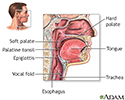Laryngitis
Hoarseness - laryngitis
Laryngitis is swelling and irritation (inflammation) of the voice box (larynx). The problem is most often associated with hoarseness or loss of voice.
Causes
The voice box (larynx) is located at the top of the airway to the lungs (trachea). The larynx contains the vocal cords. When the vocal cords become inflamed or infected, they swell. This can cause hoarseness. Sometimes, the airway can get blocked.
The most common form of laryngitis is an infection caused by a virus. It may also be caused by:
- Allergies
- Bacterial infection
- Bronchitis
- Gastroesophageal reflux disease (GERD)
- Injury to the throat
- Irritants and chemicals
- Overuse of the voice
Laryngitis often occurs with an upper respiratory infection, which is typically caused by a virus.
Several forms of laryngitis occur in children that can lead to a dangerous or fatal respiratory blockage. These forms include:
Symptoms
Symptoms may include:
- Fever
- Hoarseness
- Swollen lymph nodes or glands in the neck
Exams and Tests
A physical exam can often decide if hoarseness is caused by a respiratory tract infection.
People with hoarseness that lasts more than a month (especially smokers) should see an ear, nose, and throat specialist (otolaryngologist). An exam of the throat and upper airway will be done, often with a flexible scope.
Treatment
Laryngitis is often caused by a virus, so antibiotics likely will not help. Your health care provider will make this decision.
Resting your voice helps to reduce inflammation of the vocal cords. A humidifier may soothe the scratchy feeling that comes with laryngitis. Decongestants and pain medicines may relieve the symptoms of an upper respiratory infection.
Outlook (Prognosis)
Laryngitis that is not caused by a serious condition often gets better on its own.
Possible Complications
In rare cases, severe respiratory distress develops. This requires immediate medical attention.
When to Contact a Medical Professional
Contact your provider if:
- A small child who is not teething has difficulty breathing, swallowing, or is drooling
- A child less than 3 months old has hoarseness
- Hoarseness has lasted for more than 1 week in a child, or 2 weeks in an adult
Prevention
To prevent getting laryngitis:
- Try to avoid people who have upper respiratory infections during cold and flu season.
- Wash your hands often.
- Do not strain your voice.
- Stop smoking. This can help prevent tumors of the head and neck or lungs, which can lead to hoarseness.
References
Allen CT, Nussenbaum B, Merati AL. Acute and chronic laryngopharyngitis. In: Flint PW, Francis HW, Haughey BH, et al, eds. Cummings Otolaryngology: Head & Neck Surgery. 7th ed. Philadelphia, PA: Elsevier; 2021:chap 61.
Flint PW. Throat disorders. In: Goldman L, Cooney KA, eds. Goldman-Cecil Medicine. 27th ed. Philadelphia, PA: Elsevier; 2024:chap 397.
Rodrigues KK, Roosevelt GE. Acute inflammatory upper airway obstruction (croup, epiglottitis, laryngitis, and bacterial tracheitis). In: Kliegman RM, St. Geme JW, Blum NJ, et al, eds. Nelson Textbook of Pediatrics. 22nd ed. Philadelphia, PA: Elsevier;2025:chap 433.
Review Date: 10/9/2024












